Edward’s achievements
Edward is most notable for his early years. In 1330, with a band of friends he invaded Nottingham castle, arrested his mothers lover, Roger Mortimer and subsequently executed him.It is possible he took this action to prevent any possibility that a union between his mother and Mortimer would result in his own claim to the throne being challenged. Possibly he knew that Mortimer rather than Edward II was his father, making him illegitimate and therefore extremely vulnerable.
The link to Ximene
The earlier manoeuvering and subsequent treachery which lead to the Wars of the Roses started immediately after Ximene arrived in England in 1356. I have found it necessary to understand the full story in order to write about Ximene’s interaction with members of the royal family and the petty jealousies she encountered. All Ximene’s friends, the Roet sisters and Joan of Kent, and her relatives the Perez sisters helped shape the next generation, it’s attitudes and it’s ambitions. Ximene is of course fictional. She has been invented to explain the meteoric rise oF John Stanley, who went from a Forrester’s Son to king of the Isle of Man within his lifetime. The other six women are real and they really did change history. I have depicted Ximene as the seventh woman who co-ordinated and perhaps inspired the actions of the others.
What lies in wait
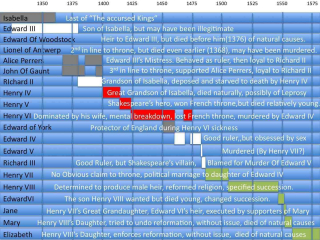 Despite continuing conflict which in turn had a detrimental affect on every aspect of the administration of the state there were only five changes to the succession brought about by the Wars. The futility of the fighting and the short term changes in fortune can be judged by the fact that both Edward IV and Henry IV ruled for two separate periods. The conflict extended far beyond the period normally covered by conventional histories. The major battles cannot be separated from the context of the family tensions and external influences which led to the conflict, or from the ruthless way the Tudor dynasty, once it came to power, systematically eliminated all potential competitors. The events of Edward III’s reign and the influence of six women lead directly to eighty years conflict, known as “the Wars of the Roses”. Henry Bolingbroke set himself against the ambitions of these women. They and their descendants fought back.
Despite continuing conflict which in turn had a detrimental affect on every aspect of the administration of the state there were only five changes to the succession brought about by the Wars. The futility of the fighting and the short term changes in fortune can be judged by the fact that both Edward IV and Henry IV ruled for two separate periods. The conflict extended far beyond the period normally covered by conventional histories. The major battles cannot be separated from the context of the family tensions and external influences which led to the conflict, or from the ruthless way the Tudor dynasty, once it came to power, systematically eliminated all potential competitors. The events of Edward III’s reign and the influence of six women lead directly to eighty years conflict, known as “the Wars of the Roses”. Henry Bolingbroke set himself against the ambitions of these women. They and their descendants fought back.
Despite continuing conflict which in turn had a detrimental affect on every aspect of the administration of the state there were only five changes to the succession brought about by the Wars. The futility of the fighting and the short term changes in fortune can be judged by the fact that both Edward IV and Henry IV ruled for two separate periods. The conflict extended far beyond the period normally covered by conventional histories. The major battles cannot be separated from the context of the family tensions and external influences which led to the conflict, or from the ruthless way the Tudor dynasty, once it came to power, systematically eliminated all potential competitors.
The Italian banks
In 1341 Edward III solved one of England’s greatest problems; the debts to the Italian banks. He reneged on the debts, justifying his action on the policies of usury being utilised by the banks.
He used his wife’s contacts to bring flemish weavers to England to break the trading monopoly penalising the suppliers of raw wool.
To bolster his economic position he created trading monopolies, particularly between England and Aquitaine on which the crown took a percentage.
Crecy
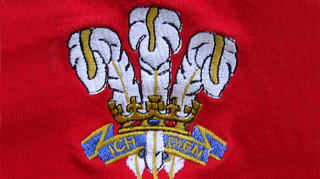 In 1346 he attacked the Franks on their home territory winning the battle of Crecy, on the fringe of the Capet king’s base using innovative techniques which eliminated the core of the Frankish aristocracy.
In 1346 he attacked the Franks on their home territory winning the battle of Crecy, on the fringe of the Capet king’s base using innovative techniques which eliminated the core of the Frankish aristocracy.
Calais
 It is one of the great anomalies of history that it was on the site of this his greatest victory that his personality seemed to change. Almost immediately afterwards he permitted his wife to interceed on behalf of the burgers of Calais who had resisted him in an extended siege. This was followed almost immediately by his attempt to rape Joan of Kent at the ball to celebrate the great victory.
It is one of the great anomalies of history that it was on the site of this his greatest victory that his personality seemed to change. Almost immediately afterwards he permitted his wife to interceed on behalf of the burgers of Calais who had resisted him in an extended siege. This was followed almost immediately by his attempt to rape Joan of Kent at the ball to celebrate the great victory.
He relinquished military control to his sons and allowed the women around him to exert increasing control over politics and government.
Nevertheless In 1360, King Edward III was a succesful King.
His son, the Black Prince, though impetuous was considered to be a brilliant military strategist and “The flower of chivalry”, an eminently suitable candidate to assume the role of king.
Alyse Perrers
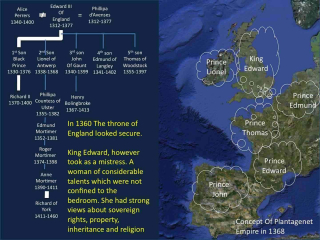 However there were by now some significant concerns. King Edward took a mistress, a mystery woman from outside of the normal royal circle. Alice Perrers (Alyse Perez?) had political objectives.
However there were by now some significant concerns. King Edward took a mistress, a mystery woman from outside of the normal royal circle. Alice Perrers (Alyse Perez?) had political objectives.
She was not just the Kings mistress but she invented the profession of legal soliciting, representing her clients in parliament and usually winning the cases she represented. Probably her success had a lot to do with her close relationship with the King, but the fact remained that she invented the process and by getting the judgements of the House of Lords she was setting common law precedents.
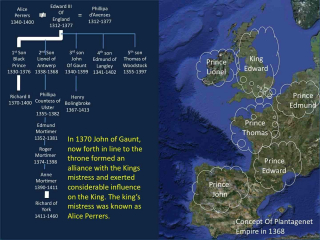 John of Gaunt, King Edward’s third son supported Alice Perrers against her political opponents. They were involved in a systematic programme to limit the powers both of the great lords and the Church of Rome.
John of Gaunt, King Edward’s third son supported Alice Perrers against her political opponents. They were involved in a systematic programme to limit the powers both of the great lords and the Church of Rome.
Shakespeare propaganda
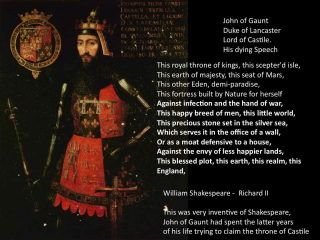 The history of what happened from this point becomes blurred because of the way Shakespeare told the story. Shakespeare may be a great author but he was also an unashamed propagandist for the Tudor dynasty. Not everything in his plays is accurate, much of it functions well as Tudor propaganda.
The history of what happened from this point becomes blurred because of the way Shakespeare told the story. Shakespeare may be a great author but he was also an unashamed propagandist for the Tudor dynasty. Not everything in his plays is accurate, much of it functions well as Tudor propaganda.
Geoffrey Chaucer
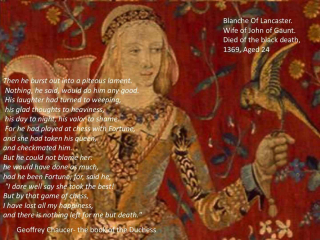 Much of what happens is covered by another great author, Geoffrey Chaucer who was a contemporary of John of Gaunt, Richard II and Alice Perrers. His writings are more oblique but also critical of aspects of court life. He was certainly close to those of influence. He married Phillipa de Roet, sister of John of Gaunt’s mistress, though possibly the marriage was a cover for Gaunt having affairs with both sisters. Chaucer’s “Book of the Duchess” simulates a conversation with John of Gaunt after the death of his first wife, Blanche of Lancaster.
Much of what happens is covered by another great author, Geoffrey Chaucer who was a contemporary of John of Gaunt, Richard II and Alice Perrers. His writings are more oblique but also critical of aspects of court life. He was certainly close to those of influence. He married Phillipa de Roet, sister of John of Gaunt’s mistress, though possibly the marriage was a cover for Gaunt having affairs with both sisters. Chaucer’s “Book of the Duchess” simulates a conversation with John of Gaunt after the death of his first wife, Blanche of Lancaster.
An Infant King
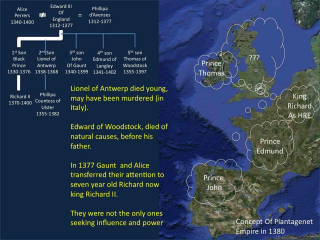
When the Black Prince died in 1374 his son, Richard II, only four years old became heir to the throne. There seemed little chance of a constitutional crisis as he had a strong, politically astute and popular mother in Joan of Kent. Just as importantly his powerful Uncle, John of Gaunt, Duke of Lancaster, swore allegience to him and took control of the process of grooming him to become the next King.
However, Gaunt’s support of Alice allowed her influence to extend beyond the death of King Edward in 1377. Richard was still only seven years of age and Gaunt was now the effective Regent. Parliament tried to limit the power of both Alice and Gaunt but to little effect.
Gaunt and Alice also supported the activities of John Whycliffe, an academic theologian turned minister and evangelist, who was very critical of the activities of the Church of Rome. Whycliffe created an extensive following known as the “Lollards” . The movement coexisted with the central areas of the Peasants revolt of 1381 and may have been instrumental in inspiring a desire for change.
The cousins
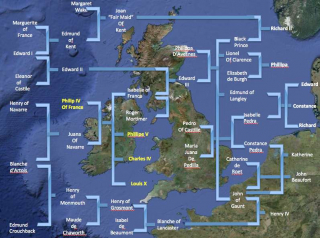
As Richard came the throne he had significant rivals amongst his cousins and when he failed to produce an heir the plots and counter plots proliferated. there were four male cousins Edward of York,Richard of Conisburgh, Henry Bolingbroke and John Beaufort. However under English law, the heir to the throne if Richard II were to die without issue would be Phillipa of Ulster (Clarence). Incredibly she married Edmund Mortimer son of Roger Mortimer, Queen Isabelle’s lover who had been executed by Edward III.
The Perez Sisters
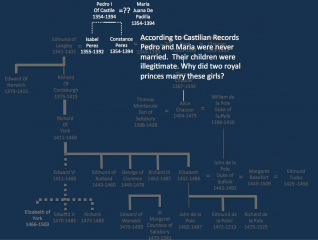 One of the unexplained mysteries of history is why two princes of the royal blood married two Castilian sisters who were illegitimate. In fact it is rarely commented on. There is little doubt they were illegitimate. There even seems to be an attempt at some time in the past to hide their identity they are often called Constance Pedra and Isabelle Perez. I have made the king’s mistress Alyse Perrers a third sister (Perrers -Perez?). in view of the way that concepts of right to rule dominated the thinking of Edward III’s mother
One of the unexplained mysteries of history is why two princes of the royal blood married two Castilian sisters who were illegitimate. In fact it is rarely commented on. There is little doubt they were illegitimate. There even seems to be an attempt at some time in the past to hide their identity they are often called Constance Pedra and Isabelle Perez. I have made the king’s mistress Alyse Perrers a third sister (Perrers -Perez?). in view of the way that concepts of right to rule dominated the thinking of Edward III’s mother
The de Roet sisters
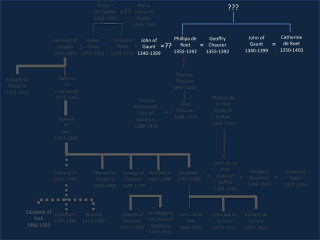 The de Roet sisters, Phillipa and Catherine present a similar conumdrum. John of Gaunt had children by both of the sisters. In fact Gaunt had children by three of the five ladies we are considering. It is supposed to be that the ladies were very attractive and Gaunt was unable to resist them.
The de Roet sisters, Phillipa and Catherine present a similar conumdrum. John of Gaunt had children by both of the sisters. In fact Gaunt had children by three of the five ladies we are considering. It is supposed to be that the ladies were very attractive and Gaunt was unable to resist them.
It was more likely to be the boodlines but what was the bloodline of the de Roet sisters? They did not originate in Seville. Their father was relatively insignificant knight.
There is an opinion amongst some genealogists, that their mother was the sister of Queen
Phillipa, Edward III’s wife. This is supported by the fact that when John of Gaunt eventually married Katherine de Roet is was necessary to get a dispensation due to the closeness of their relationship.
If the theory about her mother is correct they were close, Katherine was Gaunt’s Cousin!if this is not true then “the closeness of their relationship becomes a puzzle.
And the Bloodline? Phillipa’s family had its own brand of “Holy Blood”. it was one of the recipients of the Dagobert Line, Which claimed descent from Jesus. Suppose, just suppose that these two bloodlines were intermingled and that the ladies in question made a pact that they would choose partners so that they would dominate the future English royal family no matter which faction succeeded?! A repeat of what the Egyptians had done in Persia, Greece and Rome.
The Beauforts
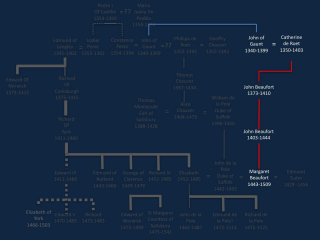 It had seemed unlikely at times, but it was Katherine de Roets line which finally came to power through Margaret Beaufort’s son Henry Tudor. At least that is what the historians tell us. The same historians tell us that Henry’s subsequent marriage to Elizabeth of York was meaningless. Elizabeth’s father, Edward VI was rumoured to be fathered by a french archer and therefore not of the royal blood.
It had seemed unlikely at times, but it was Katherine de Roets line which finally came to power through Margaret Beaufort’s son Henry Tudor. At least that is what the historians tell us. The same historians tell us that Henry’s subsequent marriage to Elizabeth of York was meaningless. Elizabeth’s father, Edward VI was rumoured to be fathered by a french archer and therefore not of the royal blood.
Suppose, just suppose that story that Edward IV was fathered by a French Archer was just French propaganda supported by forged documents.
The marriage between Henry Tudor and Elizabeth of York then acquires an importance far beyond the intricacies and competitiveness of the Plantagenets. It becomes the final union of the two distinct strains of the Sangreal. Suppose, just suppose that the whole of the Wars of the Roses was to ensure that house of Lancaster founded by Henry Bolingbrake, who did not possess the precious bloodlines, were removed from power?
Suppose the Beauforts were not Lancastian supporters at all but supporters of the right to rule given to them by the Sangreal. Why then would they act so determinedly to remove Richard III, who carried the Castilian bloodline. Perhaps because he did arrange the murder of the princes in the tower and thus proved himself unworthy.
Suppose the underlying objective was to remove this island nation from the control of the Church of Rome! there is enough known about Richard to suggest he had a close affinity for the Church of Rome, seen by some as a redeeming feature. However in terms of the initiative by his family to escape from Rome this marked him out as a traitor.
The Chaucers
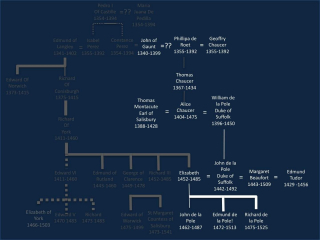 In fact this was not the first time a merger of the blood lines had been attempted. Margaret Beaufort, as a child, had been married to John de la Pole. The marriage was dissolved, nominally because of the interference of Henry VI but possibly because it was known that the descendants of Phillipa de Roet had shifted their allegiance to the Church of Rome.
In fact this was not the first time a merger of the blood lines had been attempted. Margaret Beaufort, as a child, had been married to John de la Pole. The marriage was dissolved, nominally because of the interference of Henry VI but possibly because it was known that the descendants of Phillipa de Roet had shifted their allegiance to the Church of Rome.
Margaret herself projected an image of great piety, but which god she believed in is far from clear. What is certain is that she believed in her son’s “right to rule”
